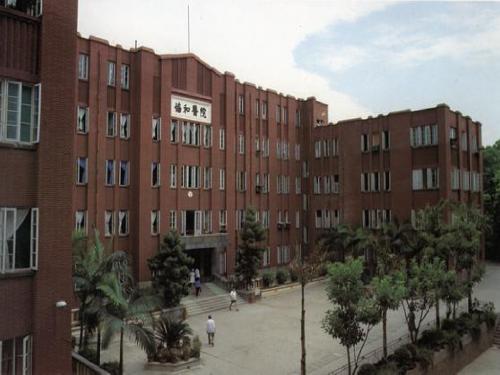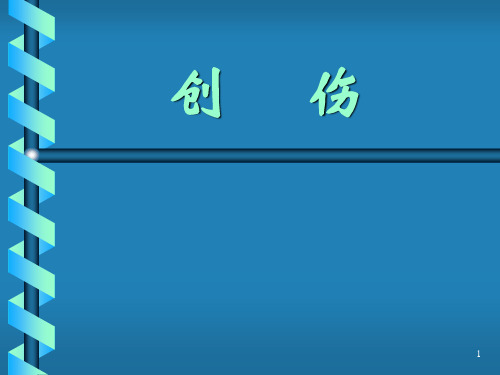《外科学》创伤与战伤(留学生)
外科学创伤与战伤

创伤的分类
按创伤部位分类(致伤部位)
腹部伤:易发生。
实质脏器内出血
空腔脏器腹腔感染
创伤
创伤的分类
按创伤部位分类(致伤部位)
骨盆部(阴臀部)伤:易致开放性损
伤,伤部极易受到污染。
创伤
创伤的分类
按创伤部位分类(致伤部位)
脊柱脊髓伤
脊柱骨折脊柱稳定性受到影响
脊髓损伤截瘫、残疾
创伤
创伤的分类
伤 情 分 类 优先处理伤:颈椎损伤、呼吸功能减弱、心血 管功能不全、严重外出血 较优先处理伤:胸腔腹腔、颅脑伤、脊髓伤、 四肢血管伤、严重烧伤、面部软 组织伤等
创伤
创伤的急救
原 则 按先重后轻抢救
伤 情 分 类 优先处理伤:颈椎损伤、呼吸功能减弱、心血 管功能不全、严重外出血 较优先处理伤:胸腔腹腔、颅脑伤、脊髓伤、 四肢血管伤、严重烧伤、面部软 组织伤等
创伤
创伤的分类
按有无伤口分类(体表结构的完整性) 常见的闭合性损伤
挫伤:钝性暴力所致的皮下软组织损
伤,最常见,伤处肿胀、瘀血、疼痛,严
重者可造成实质细胞的坏死和功能障碍。
创伤
创伤的分类
按有无伤口分类(体表结构的完整性) 常见的闭合性损伤 挤压伤:肌肉组织丰富的肢体或躯干+
重物长时间挤压或固定体位的自压,导致 肌肉组织损伤。受压部位出现严重缺血, 造成组织细胞变性坏死,大量的细胞崩解 产物如血红蛋白、肌红蛋白等被吸收后引 起急性肾衰,称为挤压综合征。
创伤
创伤的诊断
病 史
了解受伤的过程、身体姿势、外力作用部位等 伤后出现的局部及全身症状和演变过程
经过何种处理和处理时间
既往疾病史
创伤
创伤的诊断
《外科学》教案第三章第一节第二节

章第一节第二节•教案背景与目的•第三章概述•第一节:外科感染•第二节:创伤与战伤目录•教学方法与手段•教学评估与反馈教案背景与目的课程背景《外科学》是医学领域中的一门重要学科,涵盖了各种手术操作及其相关理论知识。
第三章主要介绍了手术基本操作和技能,包括手术器械使用、手术缝合、止血等。
第一节和第二节分别针对手术器械使用和手术缝合进行深入讲解,是外科学学习的基础内容。
教学目标能力目标知识目标能够正确、熟练地使用手术器械;能够独立完成简单的手术缝合操作。
情感目标教学内容与方法教学内容教学方法第三章概述包括外科学的定义、历史、发展及基本原则等。
外科学基本概念和原则常见外科疾病及其治疗外科手术基本操作围手术期处理涵盖常见外科疾病的病因、病理生理、临床表现、诊断和治疗等方面。
介绍外科手术的基本操作,如切口、止血、缝合等。
阐述手术前、手术中及手术后的处理措施,包括病人的准备、麻醉选择、术后护理等。
第三章主要内容重点与难点重点难点学习方法建议01020304认真听讲多看多练理论与实践相结合拓展阅读第一节:外科感染外科感染概述外科感染定义外科感染分类根据病程可分为急性、亚急性与慢性感染;根据病原菌种类和病变性质可分为非特异性感染和特异性感染。
常见外科感染类型及特点第二季度第三季度第一季度第四季度疖痈丹毒急性蜂窝织炎外科感染的诊断与治疗原则诊断原则治疗原则第二节:创伤与战伤创伤定义创伤分类创伤评估030201创伤概述包括擦伤、挫伤、切割伤等,处理原则为清创、止血、包扎、预防感染。
软组织损伤包括肝脾破裂、胃肠破裂等,处理原则为积极抗休克、手术治疗为主。
腹部损伤处理原则为复位、固定、功能锻炼,注意预防并发症。
骨折与关节脱位颅脑损伤包括肋骨骨折、气胸、血胸等,处理原则为保持呼吸道通畅、恢复胸壁完胸部损伤0201030405常见创伤类型及处理原则战伤特点及救治策略战伤特点伤情复杂、伤势严重、多发伤和复合伤多见、感染率高。
救治策略优先处理危及生命的伤情,如止血、保持呼吸道通畅、抗休克等;及时清创、预防感染;重视心理干预和康复治疗。
《外科学》创伤与战伤(英文)

DEFINITION
Trauma is the injury caused by mechanical or chemical factors, which leads to tissue integrity damaged and loss of function.
Chapter 1 Classification of the Trauma
3. Wound causing factors
Cold weapon wounds (冷兵器伤): Knife Firearm wounds (火器伤): gun Burns(烧伤): High temperature Cold injury(冷伤): Low temperature Blast injury (冲击伤): 爆震伤 Chemical injury (化学伤): chemical weapon Radiation injury (放射性损伤): Electromagnetic radiation,Particulate radiation
Trauma And War Injury
Risk factors
Traffic accident, industrial injury, Natural disaster, war injury and so on.
CONTENT
1. The concept of trauma. 2. The classification of trauma. 3. The pathphysiology of trauma. 4. The diagnosis of trauma. 5. The treatment of trauma.
Immunomodulating
Both glucocorticoids and catecholamines directly inhibit the production of type 1 cytokines, such as IL-12, IL-2, TNF-α and INF-γ, that enhance cellular immunity and T-helper 1 (Th1) formation and conversely favor the production of type 2 cytokines, such as IL-10, IL-4, IL-13, that induce humoral immunity and T-helper 2 (Th2) formation. Thus, during an immune challenge, stress causes an adaptive Th1 to Th2 shift in order to protect the tissues from the potentially destructive actions of the pro-inflammatory type 1 cytokines and other products of activated macrophages. The homeostatic role of stress-induced Th2 shift against overshooting of cellular immunity often complicates pathologic conditions where, either cellular immunity is beneficial (e.g. carcinogenesis, infections) or humoral immunity is deleterious (e.g. allergy, autoimmune diseases).
外科学(总论)_王柏群_第十三章创伤和战伤PPT课件

4、创伤检查的注意事项 1).发现危重情况必须立即抢救 2).检查步骤尽量简捷 3).重视症状明显部位 4).不可忽视异常安静的病人 5).一时性难以诊断清楚的损伤
应密切观察
二、创伤的处理
1、急救 1).复苏 2).通气 3).止血 4).包扎 5).固定 6).搬运
2、进一步救治 1).判断伤情 2).呼吸支持 3).循环支持 4).镇静止痛和心理治
擦伤,表浅的小刺伤和小切割伤,可 用非手术治疗。其它的开放性创伤均需手 术处理。
7、康复治疗 包括物理治疗和功能练习,特别是对
骨折和神经损伤更有必要。
二、病理 (一)、局部反应 主要表现为炎症反应 (二)、全身反应 是一种非特异性应激反应 1、神经内分泌系统变化:共同 调节全身各器官功能和代谢,动 员机体的代偿能力,以对抗致伤 因素的损伤作用。
3、影响创伤愈合的因素
1)局部
2)全身
(四)、创伤并发症
1、感染
2、休克
3、脂肪栓塞综合症
4、应激性溃疡
第一节 创伤概念
一、概念和分类 广义,指机械、物理、化学或生物等
因素造成的机体损伤。 狭义,指机械性致伤因素作用于机体
所造成组织结构完整性破坏或功能障碍。 1、按致伤因素分类 烧伤、冷伤、挤压伤、刀器伤等
ห้องสมุดไป่ตู้
2、按受伤部位分类 颅脑伤、颌面部伤、颈部伤等
3、按伤后皮肤完整性分类 闭合伤、开放性
4、按伤情轻重分类 轻、中、重伤
5、凝血功能障碍
第二节 创伤的诊断与治疗
一、创伤的诊断 1、受伤史 1).受伤情况 2).伤后表现及其演变过程 3).伤前情况
2、体格检查 1).全身情况的检查 2).根据受伤史或某处突出的体征,详
医学课件外科学总论13创伤和战伤

29
开放性创伤的处理
• 清洁伤口 (cleaning wound) • 污染伤口 (contaminated wound
清创术 • 感染伤口 二期(延期)愈合
异物存留
30
浅部软组织创伤 •挫伤 •刺伤 •切割伤
31
清创术 debridement
• 清洗去污 汽油/乙醚 肥皂液 盐水/冷开水
切口类型
Ⅰ类切口 Ⅱ类切口 Ⅲ类切口
切口愈合
甲级愈合 乙级愈合 丙级愈合
17
不利于创伤修复的因素
• 局部因素 : 伤口特点 (血运障碍
感染 异物存留或失活组织过多 缝合技术和材料 制动不够
• 全身因素 (年龄、营养、维生素、
(慢性疾病、 (激素水平 (心理压力
18
(四)创伤并发症
• 1.感染 • 2.休克 • 3.脂肪栓塞综合症 • 4.应激性溃疡 • 5.凝血功能障碍 • 6.器官功能障碍
25
治疗
• 体位和局部制动 • 镇痛镇静和心理治疗 • 感染的防治 • 休克的防治
26
治疗
• 维持体液平衡和营养代谢 • 开放性创伤的处理 • 闭合性创伤的处理 • 功能练习
27
(三)急救程序 (四)批量伤员的救治
28
闭合性创伤的治疗
软组织挫伤----冷敷、中药外敷 骨 折----复位、固定 脏 器 损伤----手术或观察 头 部 伤----包扎(穿刺)降温
3%双氧水 碘酒 酒精 01%洗必泰 新洁尔灭 碘伏
• 清理伤口 • 缝合伤口 Ⅰ期缝合 Ⅱ期缝合 • 包扎伤口
32
感染伤口的处理
• 呋喃西林外敷 • 苯氧乙醇/磺胺米隆 • 高渗盐水 • 10%硝酸银
第十四章 创伤和战伤

第十四章创伤和战伤
1.开放性创伤的伤口分哪三类?清创的原则是什么?
答:清洁伤口、污染伤口、感染伤口。
开放性创伤的早期污染伤口可行清创术,直接缝合或者延期缝合,较深入体内的创伤在手术中必须仔细探查和修复。
伤口和组织内存有异物,应尽量取出利于组织修复;但如果异物数量多、或者摘取时可能造成严重的再次损伤,处理时必须衡量利弊。
2.叙述创伤的全身临床表现及其病理基础。
答:1、体温增高:为损伤区血液成分及其他组织成分的分解产物吸收所引起,一般在38°左右。
体温过高,除了可由脑损伤引起,一般为并发感染所
致,应于重视。
2、脉搏、血压和呼吸的改变:伤后儿茶酚胺释出增多,可使脉搏和心率加
快,周围血管收缩,故舒张压可上升,收缩压可接近正常或稍高,脉压
缩小。
但如发生大出血或休克,则因心搏出量明显减少,血压降低,脉
搏细弱。
一般的创伤病人,呼吸多无明显改变。
较重的创伤常使呼吸
加快,其原因可能是换气不足使机体缺氧、失血多或休克等,有时可能
与精神紧张、疼痛等有关。
3、其他:如口渴、尿少、疲惫、失眠、食欲不振等,妇女可发生月经失调。
3. 开放伤的分类?各类伤口的性质及处理原则。
4. 叙述创伤全身性病理反应。
5. 损伤分几类?每种损伤有何病理生理特点?
6. 怎样促使伤口愈合?。
外科学创伤与战伤1

外科教研室
创伤概述
损伤----是指人体受各种致伤因子作用后发生组织结构破坏 和功能障碍。 创伤----由机械因素所致的损伤。 战伤----在战争条件下所发生的损伤。
▲ 无论平时或战时,损伤均多见,故在外科领域中占有重要 地位。
▲ 损伤分类 (一)按致伤因素分类
刺伤、切割伤、冷伤、火器伤、复合伤等。
▲ 损伤的修复 (一)修复过程3阶段: 1. 局部炎症反应阶段 2. 细胞增殖分化和肉芽组织生成阶段 3. 组织塑形阶段
(二)创伤愈合分为:
1.一期愈合
组织修复以原来的细胞为主, 组织损伤少,创缘整齐,无感 染,或无菌手术切口缝合后, 愈合后仅留一条线形疤痕。
2.二期愈合
组织修复以纤维组织为主,组 织缺损较多,创缘不整齐,或 有感染的创口,其愈合时间显 著延长,疤痕明显。
和全身表现、处理经过等。 2.全身检查 3.局部检查 4.辅助检查
▲ 损伤的处理 (一)处理原则 ①把保存伤员生命放在首位。 ②尽可能保存或修复损伤的组织与器官,并恢复其功能。 ③积极防治全身与局部各种并发症。
(二)现场急救
1.除去致伤因素避免继续损伤
2.优先抢救心跳骤停、窒息、大出血、开放气胸、休克、 内脏脱出等,以挽救生命。
体温高、脉快、尿 少、精神差、无食 欲
以变质渗出 为主
第二期 垂体-肾上 腺激素分泌 趋向正常
氮代谢开始转为正 体温、脉搏逐渐恢
平衡,钠排出增加, 复变慢
以肉芽组织 增生为主
第三期 恢复正常
正氮平衡、钾、钠 平衡,脂肪储存
逐渐恢复正常活动 体重、体力恢复。
以纤维组织 增生为主, 伤口愈合。
(二)按致伤部位分
一般按解剖分为颅脑部、 颌面颈部、脊柱脊髓部、 胸部、腹部、骨盆部、上 肢和下肢等八个部位。
外科学课件:创伤和战伤

多余毛细血管消退、粘蛋白水分减少
2、创伤愈合的类型
一期愈合 二期愈合
(2)影响因素
局部性
*感染*异物、坏死组织、血块*血循
环差*软组织缺损*固定不良
全身性
*低蛋白血症、贫血* 免疫功能差* 维 生素缺乏* 水与电解质平衡失调* 某 些药物
(4)创伤并发症
3、 循环支持休克复苏
及时有效平稳. 补液、输血的问题 血管活性物质的应用
4.镇静止痛心理治疗 5.防治感染 6.密切观察 7.支持治疗
(三)急救程序
把握生命体征,迅速评估伤情 对生命体征的重要改变迅速作出反应 重点问病史,仔细体查 实施各种穿刺、检查 进行确定性治疗
(四)批量伤员救治
2.9:1 11.03%
年龄
15-30岁 30-45岁
38.82% 24.18%
45-60岁 13.49%
第一节 创伤概论
一、概念和分类
(一)概念:
创伤的狭义概念:机械性致伤因素 作用于人体所造成的组织结构完整 性的破坏或功能障碍
创伤的广义概念:外源性致伤因素 作用于人体所造成的组织结构完整 性的破坏或功能障碍
(二)全身反应
1、神经内分泌系统变化 2、代谢变化
1、神经内分泌系统的改变
➢ 交感神经、肾上腺髓质反应 ➢ 下丘脑、垂体、肾上腺皮质反应 ➢ 肾素、血管紧张素醛固酮系统 ➢ 其它:
胰岛素 胰高血糖素 生长激素 甲状腺素 抗利尿激素
2、代谢变化
高分解变化—分解 , 合成 应急性高血糖素
创伤时糖利用率<0.2g/kg.h (正常0.3--0.5g/kg.h)
2、穿刺和导管检查 诊断性穿刺检查:简捷可行,无需特 殊设备,多用于闭合伤的诊断。
- 1、下载文档前请自行甄别文档内容的完整性,平台不提供额外的编辑、内容补充、找答案等附加服务。
- 2、"仅部分预览"的文档,不可在线预览部分如存在完整性等问题,可反馈申请退款(可完整预览的文档不适用该条件!)。
- 3、如文档侵犯您的权益,请联系客服反馈,我们会尽快为您处理(人工客服工作时间:9:00-18:30)。
2. Neuroendocrine response
1. Sympathetic / adrenocortex system
2. Hypothalamus / pituitarቤተ መጻሕፍቲ ባይዱ system
3. Renin-angiotension system
1.SNS - Neurohormonal response Stimulated by sympathetic/adrenocortex system (catecholamine )
Schematic representation of the interactions between the stress and the immune system. LC/NE: locus ceruleus/norepinephrinesympathetic system, SPGN: sympathetic postgaglionic neurons, CRH: corticotropin-releasing hormone, AVP: arginine vasopressin, ACTH: corticotrophin, PAF: platelet activating factor, NE/E: norepinephrine/epinephrine,: Th1: T-helper lymphocyte 1, Th2: Thelper lymphocyte 2. Stimulation is represented by solid green lines and inhibition by dashed red lines.
4.SNS - Hormonal: Renin-angiotension system
Decrease renal perfusion Releases renin angiotension I angiotension II potent vasoconstriction & releases aldosterone adrenal cortex sodium & water retention
Opened injury
Opened fracture
Chapter 2 Pathophysiology of trauma
Trauma can trigger a cascade of pathological response which includes inflammatory/immune reaction, neuroendocrine response and functional change of vital organ.
Chapter 3 Repair of injured tissue
Trauma directly stimulates local tissue and triggers a cascade of tissue repair process which includes: A. Inflammation. B. Proliferation and differentiation of many types of cell—granulation formation. C. Wounds healing and car formation.
The concept of inflammation
Inflammation can be defined as a localized protective tissue response elicited by injury or destruction of tissues, which serves to destroy, dilute or wall off both the injurious agent and the injured tissues.
3. Wound causing factors
Cold weapon wounds (冷兵器伤): Knife Firearm wounds (火器伤): gun Burns(烧伤): High temperature Cold injury(冷伤): Low temperature Blast injury (冲击伤): 爆震伤 Chemical injury (化学伤): chemical weapon Radiation injury (放射性损伤): Electromagnetic radiation,Particulate radiation
1.The inflammatory/immune reaction
1. Inflammatory: local tissue inflammatory
2. Immunosuppressing: glucocorticoids inhibit inmmunocytes function.
3. Immunomodulating : Systemic inflammatory response syndrome(SIRS) Compensatory anti-inflammatory response syndrome(CARS)
DEFINITION
Trauma is the injury caused by mechanical or chemical factors, which leads to tissue integrity damaged and loss of function.
Chapter 1 Classification of the Trauma
Trauma And War Injury
Dr. Zhendong Liu The Third Xiangya Hospital
Risk factors
Traffic accident, industrial injury, Natural disaster, war injury and so on.
2. For injured place and organ
Craniocerebral injury (颅脑伤) : Chest injury (胸部伤): hematopneumothrax Abdomen injury (腹部伤): burst spleen,
perforated bowel Limbs (四肢伤): fracture, dislocation Spinal injury (脊柱伤): fracture, paraplegia
Increased heart rate Increased contractility Vasoconstriction (SVR-Afterload) Increased Preload
2.SNS - Hormonal: Adrenal Cortex
Anterior pituitary releases adrenocorticotropic hormone (ACTH).
Stimulates adrenal Cx to release glucorticoids.
Blood sugar increases to meet increased metabolic needs.
3.SNS - Hormonal: Antidiuretic Hormone
Osmoreceptors in hypothalamus stimulated ADH released by Posterior pituitary gland Vasopressor effect to increase BP Acts on renal tubules to retain water
1. For the integrity of skin
1). The opened injury :
Abrasion(摖伤) Laceration(撕裂伤) Incised wounds or cut wounds (切伤/
砍伤) Puncture wounds (刺伤)
2). The blunt injury : Contusion (挫伤) Crush injury(挤压伤) Sprain(扭伤) Concussion (震荡伤) Luxation and semiluxation (关节脱位/半脱位) Closed bone fracture (闭合性骨折) Closed internal injury (闭合性内脏伤)
Industrial injury
Natural disaster
Explosion
CONTENT
1. The concept of trauma. 2. The classification of trauma. 3. The pathphysiology of trauma. 4. The diagnosis of trauma. 5. The treatment of trauma.
Immunomodulating
Both glucocorticoids and catecholamines directly inhibit the production of type 1 cytokines, such as IL-12, IL-2, TNF-α and INF-γ, that enhance cellular immunity and T-helper 1 (Th1) formation and conversely favor the production of type 2 cytokines, such as IL-10, IL-4, IL-13, that induce humoral immunity and T-helper 2 (Th2) formation. Thus, during an immune challenge, stress causes an adaptive Th1 to Th2 shift in order to protect the tissues from the potentially destructive actions of the pro-inflammatory type 1 cytokines and other products of activated macrophages. The homeostatic role of stress-induced Th2 shift against overshooting of cellular immunity often complicates pathologic conditions where, either cellular immunity is beneficial (e.g. carcinogenesis, infections) or humoral immunity is deleterious (e.g. allergy, autoimmune diseases).
